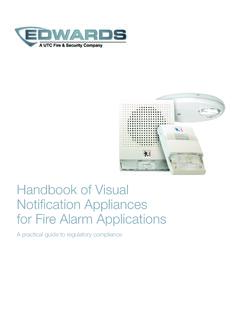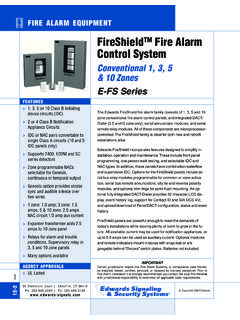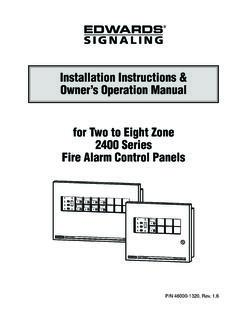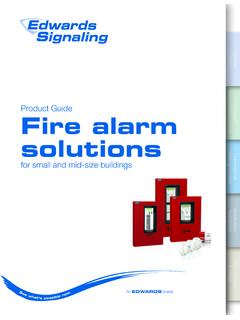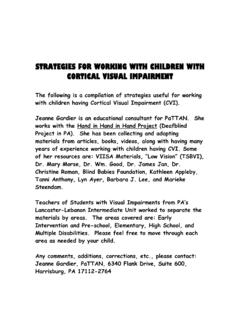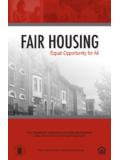Transcription of Handbook of Visual Notification Appliances for Fire Alarm ...
1 Handbook of Visual Notification Appliances for fire Alarm ApplicationsA practical guide to regulatory complianceHandbook of Visual Notification Appliances for fire Alarm ApplicationsA practical guide to regulatory complianceHandbook of Visual Notification Appliances for fire Alarm ApplicationsA practical guide to regulatory complianceCopyright 2010 UTC fire & Security All rights Town Center Parkway, Bradenton, FL 34202 Edwards P/N: 85001-0541, Issue 4-E ISBN: 0-9706268-0-0 This Handbook is for information only and is not intended as a substitute for verbatim legislated requirements. For authoritative specifications regarding the application of life safety, security, and access control systems, consult current editions of applicable codes and standards. For authoritative interpretation of those codes and standards, consult your local authority having every effort has been made to ensure the accuracy and completeness of this Handbook , the authors and publish-ers assume no responsibility for errors, inaccuracies, omissions, or any inconsistencies , and Signature Series are trademarks of UTC fire & SecurityForewordAs traditional boundaries between building systems become blurred by advances in integrated approaches, it becomes increasingly important for everyone concerned with building design and construction to have a thorough understanding of life safety equipment application.
2 Now that security and access control functions are sharing resources with life safety systems, it is no longer possible to design and install building systems in isolation of one another. Today unified building control requires a broad base of knowledge that encompasses a wide range of building control your background is in life safety, security, or access control, the success of every building system installation will ultimately rest on the effectiveness of the building s emergency warning system. Yet the application of life safety notifi-cation Appliances is one of the least understood elements of building system design and installation today. These devices hold a special place because they are not only subject to the requirements of building codes and life safety standards; they are subject to fed-eral laws as well.
3 Complicating matters further, these laws address signaling from entirely different points of view. Life safety standards are written in the context of fire Alarm application, while accessibility laws are enacted to make buildings (and their emergency signals) accessible to all building occupants, regardless of the physical challenges they face. Much of the confusion that surrounds the application of notifi-cation Appliances lies where these standards and laws Handbook will help system designers and installers identify those points of convergence in order to gain an understanding of how the requirements fit together. It will bridge the gap between legislation and practice. And it will provide readers with an overview of the changing nature of Notification Appliances and the laws that govern their Edwards we believe that the best Notification Appliances are the ones that are applied to provide the most efficient means of warning and installed to deliver the greatest level of performance.
4 We also recognize that competitive bidding is essential to achieving these goals. This Handbook will demonstrate that, despite the inherent complexities, it is possible to apply life safety Notification Appliances so that they are effective, efficient, economical, and compliant with all the prevailing of Visible Notification Appliances for fire Alarm ApplicationsEdwardsContents1. The Legislative Landscape 12. A comparison of standards requirements Photometric features Flash intensity Vertical placement (wall mounted strobes) Placement in corridors Room spacing Summary 293. Strobe Application Vertical placement (non-sleeping areas) Strobe Spacing Square rooms Rectangular rooms Irregular rooms Large rooms Applications for ceiling-mounted strobes Corridors Sleeping areas Strobes in harsh and hazardous environments Summary 464.
5 Strobe Selection Guide Listing Agencies New Technologies Understanding Current Draw Summary 545. Proposed ADA Accessibility Guidelines (ADAAG) 556. Glossary 617. Bibliography 63 Web Resources 63 Americans with Disabilities Act (ADA) 63 Codes, Standards and Listing Agencies 63 Government 64 Associations and Interest Groups 648. Index 65 Handbook of Visible Notification Appliances for fire Alarm ApplicationsEdwards, A UTC fire and Security Company 11. The Legislative LandscapeNo compliance strategy for Visual Notification Appliances can be effectively formulated without a solid understanding of the principles that underlie Visual signaling and the laws that govern their application. This chapter provides an overview that provides the basis for further discussion on Visual signaling application in the context of current standards and are Visual Notification Appliances ?
6 Visual Notification Appliances are fire Alarm devices that provide Visual notifi-cation of a life safety system event. Generally speaking, there are two kinds of directly viewed Visual Notification Appliances : those that operate in private mode and those that operate in public mode signaling is intended to alert and inform only those who are directly involved with the response to an emergency situation. Such in-dividuals include firefighters, security personnel, and others who are familiar with the operation of the fire Alarm system. Private mode Visual signaling is generally not intended to compensate for hearing impairment or high ambient noise mode signaling is intended to provide building occupants with adequate warning of danger so that they can exit the premises safely.
7 Public mode signaling Appliances serve a very different purpose from their private mode counterparts. In the public mode, signals must be unambiguous, easily recognizable by people who have little or no knowledge of fire Alarm systems, and able to reach all occupants of the building. Visual signals were developed primarily as a means to provide emergency warning to individuals who would 2 Handbook of Visible Notification Appliances for fire Alarm Applicationsnot normally hear audible signals such as a horns, bells, or function of a Visual Notification device is accomplished by means of a strobe set to flash at a prescribed frequency, or flash rate. Strobe devices are usually marked with the word fire , or a pictogram communicating the purpose of the device, and are frequently found in combination with audible signals.
8 This Handbook focuses on the standards and codes governing the application of Visual Notification Appliances , also referred to as Visual signals, operating in the public are Visual Notification Appliances needed?An estimated one in 125 Americans suffers from profound hearing loss ( : they can hear little or no sound).1 This is a significant portion of the population that would certainly benefit from Alarm strobes in the event of an hearing loss doesn t have to be absolute to render audible signals ineffective. Today, one in 11 Americans suffers some form of hearing impair-ment. Even partial hearing loss can interfere with the ability to identify an au-dible Making audible signals louder to accommodate hearing-impaired individuals is not a reasonable option because doing so could result in signals that produce sound pressure levels that cross the pain threshold and that could cause permanent damage to the hearing of people who suffer no Visual Notification Appliances find their justification among the statistics of America s hearing impaired today, it s highly unlikely that we ll find any relief in those statistics in the years to come.
9 Quite the opposite is true. It s no secret that hearing acuteness decreases with age. In fact, we all lose a decibel of hearing acuity each year past the age of As the percentage of our population reaching their senior years continues to swell over the next two decades, so too will the proportion of those who find it increasingly difficult to hear audible signals. 1 Self Help for Hard of Hearing people , Hearing Loss Journal, 2 Ibid. 3 The Legislative LandscapeEdwards, A UTC fire and Security Company 3 Hearing impairment is not the only factor that establishes a need for Visual signals. Industrial and other settings with high ambient noise levels af-fect the ability of even those with no impairments to hear emergency signals. Factories, warehouses, even nightclubs and theatres frequently have sound levels that conspire to render audible signals ineffective.
10 Workers wearing sound attenuating headsets or ear plugs risk missing audible Alarm signals, not only because the headsets cut down on the sound reaching their ears, but also because their work conditions make them likely candidates for noise-induced hearing loss, which when coupled with sound attenuating headsets makes it even more difficult to hear audible long have Visual Notification Appliances been in use?While audible signals have been required by codes and standards for nearly one hundred years, Visual signals are a relatively recent development. It was not until 1980 that requirements for Visual signals made their first appearance in building codes. Early requirements stipulated the use of flashing lights at exit signs. This limited their usefulness to points of exit and routes along the way, doing little to alert people who weren t already on the move that danger was 1990 President Bush signed the Americans with Disabilities Act (ADA), watershed legislation that provides comprehensive civil rights protec-tion to individuals with disabilities.

